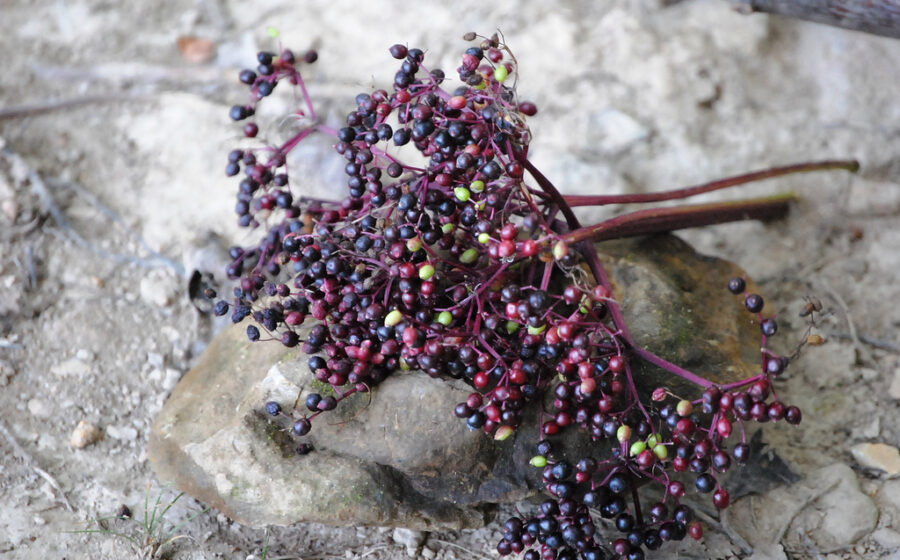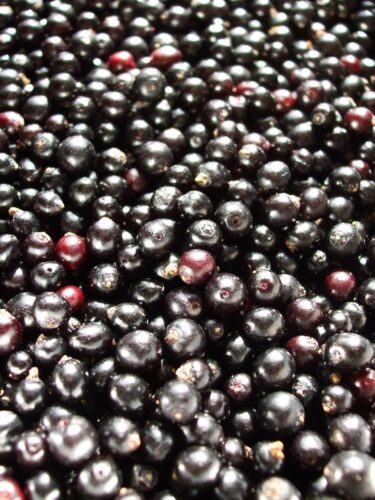[W]e needed a berry tea. Our largest wholesale client had come to us with that request, as several of their customers were asking for one. However, on first consideration it did not seem to fit with our mission of providing delicious and therapeutic herbal tisanes. Also, it seemed that most of the “berry” teas out there did not have a lot of berries in them at all, relying more on fruit essences, again not really in line with our philosophy of letting the natural herb (whole leaf, root, and flower) speak for itself. What to do?
After a little thought and research the answer became obvious in elderberry, an herb that has been used for centuries, if not millennia, by many native peoples and herbalists to treat bronchitis, upper respiratory infections, flu, and fever. Elder’s dark blue, purplish berry is also rich in both color and flavor. Though raw elderberry is slightly bitter and astringent, when processed for foods and teas elderberry has a profile somewhere between blueberry and currant, a sweet juiciness that makes it an excellent ingredient for blending with many other herbs. Elderberry lends teas a beautiful brickish wine color, a deep, complex flavor, and a wonderfully strong, complementary structure on which to hang tarter or more herbaceous tastes. Here was a berry that we could use to produce an intensely flavorful, rich tisane that would also fit with the time-honored approach of using the plant kingdom to strengthen the body and treat disease.
The word elder comes from the old Anglo-Saxon aeld, meaning fire, the hollow stems of young elder having been used to blow up a fire. This ancient use still seems relevant, as elderberry is well known in herbology for its ability to warm the body and promote perspiration, thus helping to expel toxins. We have found it a wonderful tisane to enjoy on a fall or winter evening before bed, as it imparts a sense of gentle warmth throughout the entire body, particularly the extremities. Elderberry has been shown in clinical studies to be effective for treating influenza B, one study suggesting that elderberry could shorten the duration of flu by about three days. Bioflavonoids and other proteins in the juice destroy the ability of cold and flu viruses to infect a cell, while some of those flavonoids, like anthocyanins, are powerful antioxidants as well, possessing more antioxidant capacity than either Vitamins E or C, and protect cells against damage. Some tests indicate that elderberry stimulates the body’s immune system and enhances immune function by boosting production of proteins (cytokines) that act as messengers to help regulate immune response. Here we are concerned primarily with Sambucus nigra, black elderberry, which is most often used therapeutically, though there are about thirty species around the world occurring in temperate or subtropical climates, mostly in the Northern Hemisphere.
So it’s good for us, nourishing our body and our health. But it also feeds our minds, and maybe our spirits as well. There are a host of superstitious stories associated with the elder, mostly descended from old pagan myths of Northern Europe. In most countries, elder was intimately connected with magic. In its branches dwelt the elder mother, who watched over it and the surrounding garden. Permission to use a part of the elder should always be asked first, say the legends, lest one arouse the ire of mother elder and incur her anger. True or not, we believe a respect for nature and its fruits is a wise and beneficial practice, bringing its own reward along with the taste, warmth, and health benefits of elder.
—William Sullivan co-owns B. Fuller’s Mortar & Pestle in Seattle. Photo by Laurie Hulsey.

















